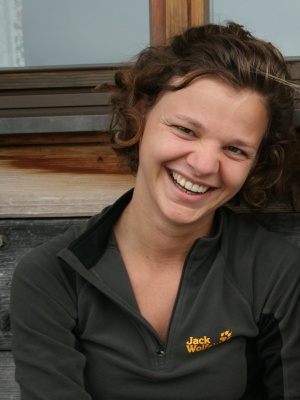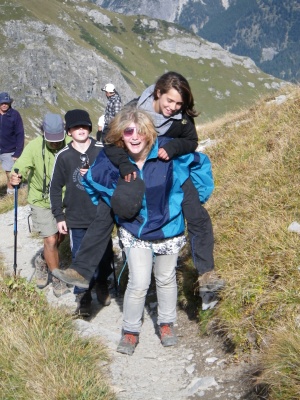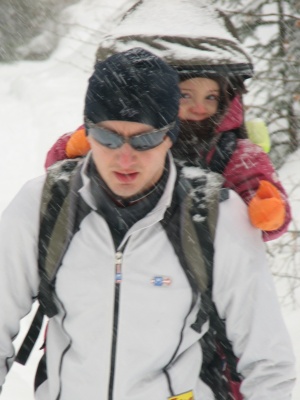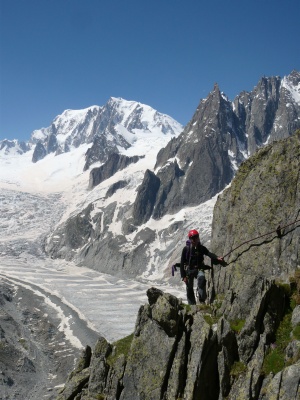Die Auswirkung der Klimaveränderung entlang der Via Alpina, die Erziehung von Jugendlichen mit sonderpädagogischem Förderbedarf durch das Wandern, und ein geofotographisches Inventar des Roten Weges: dies sind die Themen der drei Projekte, die für die Reisestipendien 2011 ausgewählt wurden, die von dem Ständigen Sekretariat der Alpenkonvention, dem Via Alpina Sekretariat des Fürstentums Monacos und dem internationalen Via Alpina Netzwerk vergeben werden:
 Durch das Projekt „Eyewitness“ (Augenzeuge) möchte Elisabeth Gsottbauer, Österreicherin, 27 Jahre alt, Doktorandin in Umweltpolitik, Umweltökonomie und Verhaltensökonomie an der Universität Autonoma Barcelona, über die Konsequenzen der Klimaveränderung kommunizieren, die bereits von den Alpenbewohnern empfunden werden. Während ca. 10 Tage im Juli 2011 wird sie die Etappen des Gelben Weges auf beiden Seiten des höchsten Punktes der Via Alpina am Niederjoch in Österreich (Tirol) und Italien (Südtirol) begehen. Unterwegs wird sie Bergbauer, Hüttenwirte, Wanderer befragen um Ihre Erfahrungen und Zukunftsvisionen weiterzugeben. PROJEKT STORNIERT! Mehr lesen >>
Durch das Projekt „Eyewitness“ (Augenzeuge) möchte Elisabeth Gsottbauer, Österreicherin, 27 Jahre alt, Doktorandin in Umweltpolitik, Umweltökonomie und Verhaltensökonomie an der Universität Autonoma Barcelona, über die Konsequenzen der Klimaveränderung kommunizieren, die bereits von den Alpenbewohnern empfunden werden. Während ca. 10 Tage im Juli 2011 wird sie die Etappen des Gelben Weges auf beiden Seiten des höchsten Punktes der Via Alpina am Niederjoch in Österreich (Tirol) und Italien (Südtirol) begehen. Unterwegs wird sie Bergbauer, Hüttenwirte, Wanderer befragen um Ihre Erfahrungen und Zukunftsvisionen weiterzugeben. PROJEKT STORNIERT! Mehr lesen >>
 Ebenfalls im Juli wird die 6. Klasse der Sonderschule Talander in Wangen im Allgäu (Deutschland) für eine fast drei-wöchige Wanderung ab Tschagguns (Montafon, Österreich) auf dem Abschnitt des Roten Weges der Via Alpina starten, der sich auf den österreichisch-schweizerischen und dann schweizerischen-italienischen Grenzen schlängelt. Für diese 10 Jungen und 2 Mädchen zwischen 13 und 14 Jahre alt geht es über die körperliche Leistung hinaus um die Stärkung ihrer sozialen Kompetenzen: Verantwortungsbewusstsein, Teamgeist, Hilfsbereitschaft, Selbstvertrauen, Initiativkraft... so wie es eine Gruppe schweizer Erwachsener letztes Jahr erleben konnte (siehe Die Heilkraft der Via Alpina). Mehr lesen >>
Ebenfalls im Juli wird die 6. Klasse der Sonderschule Talander in Wangen im Allgäu (Deutschland) für eine fast drei-wöchige Wanderung ab Tschagguns (Montafon, Österreich) auf dem Abschnitt des Roten Weges der Via Alpina starten, der sich auf den österreichisch-schweizerischen und dann schweizerischen-italienischen Grenzen schlängelt. Für diese 10 Jungen und 2 Mädchen zwischen 13 und 14 Jahre alt geht es über die körperliche Leistung hinaus um die Stärkung ihrer sozialen Kompetenzen: Verantwortungsbewusstsein, Teamgeist, Hilfsbereitschaft, Selbstvertrauen, Initiativkraft... so wie es eine Gruppe schweizer Erwachsener letztes Jahr erleben konnte (siehe Die Heilkraft der Via Alpina). Mehr lesen >>
 Für das Projekt „Photographica alpina“ wird Romain Liagre, Franzose, 32 Jahre, ein Kind, derzeit Projektbeauftragte beim Resourcenzentrum der Brüsseler Region für Obdachlosenhilfe (La Strada), für 4 Monate im Juni loslaufen. Er wird seine Kompetenzen als promovierter Geograf, seine Leidenschaft für die Alpen, wo er quasi seinen ganzen Urlaub verbringt, und seine Begabung als Fotograf kombinieren, um ein „geofotografisches Inventar“ des Roten Weges durchzuführen: alle 5 km wird er ein Foto in jeder Himmelsrichtung aufnehmen und somit eine faszinierende Datenbank aufstellen, die in der via-alpina.org Webseite integriert werden kann. Bei seiner Rückkehr wird er in den Schulen der Umgebung Lilles seine Erfahrung kommunizieren. Mehr lesen >>
Für das Projekt „Photographica alpina“ wird Romain Liagre, Franzose, 32 Jahre, ein Kind, derzeit Projektbeauftragte beim Resourcenzentrum der Brüsseler Region für Obdachlosenhilfe (La Strada), für 4 Monate im Juni loslaufen. Er wird seine Kompetenzen als promovierter Geograf, seine Leidenschaft für die Alpen, wo er quasi seinen ganzen Urlaub verbringt, und seine Begabung als Fotograf kombinieren, um ein „geofotografisches Inventar“ des Roten Weges durchzuführen: alle 5 km wird er ein Foto in jeder Himmelsrichtung aufnehmen und somit eine faszinierende Datenbank aufstellen, die in der via-alpina.org Webseite integriert werden kann. Bei seiner Rückkehr wird er in den Schulen der Umgebung Lilles seine Erfahrung kommunizieren. Mehr lesen >>
 Schliesslich hat der Selektionsausschuss das vom Französischen Berg- und Kletterverband (FFME) eingereichte Projekt mit einer besonderen Erwähnung auszeichnen wollen. Die GTA unterstützt bereits organisatorisch diese Wanderstafette über 11 Berggruppen, ausgeschmückt mit Begegnungen mit den lokalen Vereinen und gemeinsamer Ausübung einer ganzen Auswahl an Bergsportarten; daher haben wir lieber unsere finanziellen Unterstützung für die drei oben dargestellten Projekte reserviert. Aber wir möchten mit dieser Auszeichnen und der Aufnahme in der Gruppe der Reisestipendiaten 2011 unterstreichen, wie professionell dieses Projekt durchgeführt wird, das vermutlich das meist ambitionierte ist, die größte Anzahl an Personen direkt involviert und den Entdeckungs- und Begegnungsgeist der Via Alpina perfekt widerspiegelt. Mehr lesen >>
Schliesslich hat der Selektionsausschuss das vom Französischen Berg- und Kletterverband (FFME) eingereichte Projekt mit einer besonderen Erwähnung auszeichnen wollen. Die GTA unterstützt bereits organisatorisch diese Wanderstafette über 11 Berggruppen, ausgeschmückt mit Begegnungen mit den lokalen Vereinen und gemeinsamer Ausübung einer ganzen Auswahl an Bergsportarten; daher haben wir lieber unsere finanziellen Unterstützung für die drei oben dargestellten Projekte reserviert. Aber wir möchten mit dieser Auszeichnen und der Aufnahme in der Gruppe der Reisestipendiaten 2011 unterstreichen, wie professionell dieses Projekt durchgeführt wird, das vermutlich das meist ambitionierte ist, die größte Anzahl an Personen direkt involviert und den Entdeckungs- und Begegnungsgeist der Via Alpina perfekt widerspiegelt. Mehr lesen >>
Bald werden Sie den Ablauf jedes der Projekte durch dessen Blogs verfolgen können. Nach der Durchführung werden wir die Kurzfilme, die im Laufe dieser vier Abenteuer realisiert werden, online und bei diversen Veranstaltungen ausstrahlen.
Wir präsentieren Euch noch unten die Zusammenfassungen (auf Englisch) der anderen förderfähigen eingereichten Projekte. Von Bewerbern aus Frankreich, den USA, Polen, Deutschland, Italien und Österreich getragen, befassen sie sich mit sehr vielfältigem Ansatz mit Themen aus der Kunst, der Bildung oder der Regionalentwicklung. Wir wünschen, wir hätten über die Mittel verfügt um auch diese zu unterstützen, da jedes Projekt auf seiner Ebene eine wichtige Bereicherung der Via Alpina darstellt. Manche von ihnen werden trotzdem verwirklicht und werden die moralische Unterstützung der Via Alpina, des Ständigen Sekretariates der Alpenkonvention und der Via Alpina - Monaco erhalten können.
In der Reihenfolge der Einreichung:
Martine Keller: Alpenüberquerung >>
“Solo complete crossing of the Alps from Monaco to Trieste through all the countries of the alpine arc, in 4 periods, using most Via Alpina trails (blue, red, green and yellow), followed by the writing of a travel story (in French) published on a website and in paper version by self-publishing or another publishing system.
The project proposed for the contest is one part of a larger program. It is the third period and it is scheduled for July/August 2011. The first and second periods have been carried out in 2009 and 2010 and the last will take place in July/August 2012.”
E-mail: martine.keller67(at)free.fr, web: www.partance.org Fleur und Marie Daugey: Mit den Wölfen leben – wenn Natur und Kultur sich vertragen >>
“Reconciling nature and men is one of the challenges faced by mountain communities. With the return of wolves in the French and Swiss Alps, the question of living peacefully with wild predators has arisen as a difficult one. But solutions exist: associations, volunteers and shepherds work together to preserve traditional alpine farming and give a space to the predator. Like wolves, the Via Alpina crosses borders freely. Hiking this great path is a unique opportunity for us to meet alpine wildlife and cultures. And most of all, show the bonds they are building.”
E-mail: fdaugey(at)yahoo.fr
Agnieszka Kozlowska: Fernwandern in den Alpen – eine Große Tour von heute? Via Alpina Kunstinstallation >>
“I would like to explore from an artist’s perspective, the idea of a long-distance walking trip being a psychological “grand tour” of today, a way of inward travel rather than an outer-oriented one. Through walking the Via Alpina across Switzerland, Liechtenstein, Italy, Austria and Germany, and witnessing the walkers’ culture, I wish to express artistically the psychophysical experience of pedestrian alpine travel, and to communicate this state of mind to the viewer.
I envision creating an installation piece that would represent in a three-dimensional space the cross-section of the trail walked, and the material out of which this would be shaped would be inscribed during the walk with words expressing my subjective experience of the trip at particular moments. This would be complemented by a film expressing the meditative quality of walking, that consists of images of all the trail signs passed on my way that slowly blend one into another.
As an avid walker I have some experience of tackling long mountain routes in various countries. The fellowship would allow me to spend an extended period of time focused on creating a single artwork out of a long-distance route, which is something I have been planning to do for a long time. Alpine pedestrian travel, Via Alpina, Alpine nature and cultures would be promoted internationally by exhibiting the artwork to a wide audience including gallery-goers and visitors to other possible venues where the piece might be displayed.”
E-mail: agnieszka(at)kozlowska.eu, web: agnieszkakozlowska.com
Florian Huth: München – Mont-Blanc: eine fotographische Wanderung >>
“Munich, the southernmost large city of Germany, known for upscale lifestyle, Bavarian cosiness and its nearness to the Alps is the perfect starting point to begin my journey through the alpine mountains.
The aim - the Mont-Blanc - the highest mountain of Europe and the dream of many mountaineers is exactly 440.6 km air-line distance away.
Between Munich and the Mont-Blanc are the Alps, the largest mountains of Europe and enormous area for an eminent biodiversity.
Through four countries and over numerous summits, I would like to explore the variety of the Alps by foot and create a large photographic documentation.”
E-mail: mail(at)florianhuth.de, web: www.florianhuth.de
Ursula Achternkamp: Natural Born Bird Watchers >>
“The aim is to make film-portraits of people in the Alpine region. Special people: People which are observing birds. The interview partners will be amateurs, scientists, volunteers out of the Bird Watch Movement. Who are the people supporting the idea of co-existence and biodiversity, what can we learn from birds and what is their motivation for their engagement and how do they integrate this in their daily life.
The Idea is to expand the planer’s view of the “bird's-eye perspective” - to work in-situ with people who are observing birds out of different perspectives. Their personal engagements, their networks for a co-existence of nature and modernity have an important impact for an ecological turn. A research based on the experiences of people will be shown in an artistic documentary + also atmospheric film.”
E-mail: achternkamp(at)bauhaus-dessau.de
Katie Silveria: Alpine Kultur und agrarische Lebensweise: nachhaltige Entwicklung entlang der Via Alpina >>
““The world is a book, and those who do not travel read only a page.” This simple quote, coined by St. Augustine centuries ago, is the motivation for my desire to travel to Europe and trek the Alps. I have travelled in North and Central America but I have never been overseas, certainly not to any place as distinct and historically significant as the Alps. When my partner told me about this one-of-a-kind trail, a trans-Alps, multi-country route, I was instantly intrigued.
I have been aching to travel since graduating from college in 2008 but found myself working instead as a soil science research assistant, a job that has increased my understanding of sustainable agriculture and alternative farming techniques. This knowledge is what drives my Via Alpina project. I believe that one of the most important topics today is sustainable living. I am interested in sustainable development and how it can help preserve rural communities, especially in places where the loss of natural landscapes and cultural traditions would be devastating.
Before starting my trek through the Alps, I would like to research the history of the communities in the Alps and what is being done by organizations like the Alpine Convention to help sustain these groups. I hope to observe regional farming practices, niche markets, and local agro-business and gain an understanding of the connection between sustainable development, such as eco-tourism, and pre-existing Alps culture and economy. I look forward to talking with local people about the changes that are taking place in their regions and how they see their futures being affected by development. I will document and present the information I find and pictures I take on a travel blog and create a short video of my journey when I return.”
E-mail: silveria.katie(at)gmail.com
Marissa Lyons: Die Lebensart der jungen alpinen Erwachsenen >>
“The purpose of this project will be to explore the effects of alpine living on the culture and psychology of the young adult populations living in the Alps. I am interested in observing how living in remote alpine areas affects the lifestyles of those who live there. I want to investigate how the lifestyles surrounding the Alps will differ from the surrounding cities, villages and countries. For this project I will trek the majority of the Red Trail, interacting with as many people as possible and exploring the environment that undoubtedly affects the way of life of the people who live in it. I also want to practice sustainable travel and learn more about how the populations in the Alps maintain sustainable lives.”
E-mail: mlyons88(at)gmail.com
Andrea Pasqualotto / Kooperative Mazarol: Durch das alpine Erbe wandern: verschiedene Stätte / eine einzige Welt >>
“Since 1972 the UNESCO World Heritage Convention, linking together in a single document the concepts of nature conservation and the preservation of cultural properties, recognizes the way in which people interact with nature, and the fundamental need to preserve the balance between the two.
In 1991 the Convention on the Protection of the Alps, recognizing the Alps as a unique, common area, confirmed that the main goal is to develop the common heritage of the Alps and preserve it for future generations through transnational cooperation involving both countries and local authorities, as well as the scientific community, the private sector and the civil society.
According to the same spirit, the trails of the Via Alpina want to facilitate the exchange among lots of different regions, populations and cultures as the alpine ones.
The project “Walking through the Alpine Heritage: different properties – a single world” intends:
- To experience a continuous long-distance hike, called Alpine Heritage Trekking, of about 40 stages, from the Dolomites region (Italy), through the Tectonic Arena Sardona (Switzerland), to the Jungfrau-Aletsch region (Switzerland)
- To enhance the Via Alpina trails as a way to know and appreciate some alpine natural properties inscribed in the UNESCO World Heritage List
- To involve the populations which live close to those properties
- To promote the serial value that results from different properties on a transnational level.”
E-mail: endriupasq(at)hotmail.com
Pauline Lis: Die alpine Lebensweise >>
“The Alpine region shared between several European countries represents unique natural and cultural values. The Alpine Convention, and many other Alpine initiatives which promote sustainable development, preservation of its natural beauty and cultural local identities make this region an exemplary one, especially for other multicultural mountain regions in the World.
I would like to experience the cross border hike along the Via Alpina trail, through Germany, Austria, Liechtenstein and Switzerland, explore the natural beauty, the local cultural heritage and visit the most renowned modern alpine architecture - the examples of the innovative sustainable approach and of the best professional practice.”
E-mail: inapaul(at)tlen.pl
Lukas Umgeher, Stefan Mayer, Fabio Richlan: Das Kultur- und Naturgut Wasser entlang der Via Alpina erleben >>
“Not just in the central Alps but especially there, water plays a significant role in terms of landscape genesis and settlement by men.
The project is not only dedicated to the importance of water as a distinctive landscape element for instance in form of crystal clear mountain lakes, snow-capped summits and raging rivers but also as a need, opportunity and threat for the people, who live in this unique natural and cultural space in the past as well as in the present.
Selected scenes along the Purple Trail should be described in detail and thus help to raise awareness and to educate the traveling guest as well as the local population in terms of the "precious wet".”
E-mail: stef_mayer(at)hotmail.com, lukas.umgeher(at)gmx.at


 Durch das Projekt „Eyewitness“ (Augenzeuge) möchte Elisabeth Gsottbauer, Österreicherin, 27 Jahre alt, Doktorandin in Umweltpolitik, Umweltökonomie und Verhaltensökonomie an der Universität Autonoma Barcelona, über die Konsequenzen der Klimaveränderung kommunizieren, die bereits von den Alpenbewohnern empfunden werden. Während ca. 10 Tage im Juli 2011 wird sie die Etappen des Gelben Weges auf beiden Seiten des höchsten Punktes der Via Alpina am Niederjoch in Österreich (Tirol) und Italien (Südtirol) begehen. Unterwegs wird sie Bergbauer, Hüttenwirte, Wanderer befragen um Ihre Erfahrungen und Zukunftsvisionen weiterzugeben. PROJEKT STORNIERT!
Durch das Projekt „Eyewitness“ (Augenzeuge) möchte Elisabeth Gsottbauer, Österreicherin, 27 Jahre alt, Doktorandin in Umweltpolitik, Umweltökonomie und Verhaltensökonomie an der Universität Autonoma Barcelona, über die Konsequenzen der Klimaveränderung kommunizieren, die bereits von den Alpenbewohnern empfunden werden. Während ca. 10 Tage im Juli 2011 wird sie die Etappen des Gelben Weges auf beiden Seiten des höchsten Punktes der Via Alpina am Niederjoch in Österreich (Tirol) und Italien (Südtirol) begehen. Unterwegs wird sie Bergbauer, Hüttenwirte, Wanderer befragen um Ihre Erfahrungen und Zukunftsvisionen weiterzugeben. PROJEKT STORNIERT!  Ebenfalls im Juli wird die 6. Klasse der Sonderschule Talander in Wangen im Allgäu (Deutschland) für eine fast drei-wöchige Wanderung ab Tschagguns (Montafon, Österreich) auf dem Abschnitt des Roten Weges der Via Alpina starten, der sich auf den österreichisch-schweizerischen und dann schweizerischen-italienischen Grenzen schlängelt. Für diese 10 Jungen und 2 Mädchen zwischen 13 und 14 Jahre alt geht es über die körperliche Leistung hinaus um die Stärkung ihrer sozialen Kompetenzen: Verantwortungsbewusstsein, Teamgeist, Hilfsbereitschaft, Selbstvertrauen, Initiativkraft... so wie es eine Gruppe schweizer Erwachsener letztes Jahr erleben konnte (siehe
Ebenfalls im Juli wird die 6. Klasse der Sonderschule Talander in Wangen im Allgäu (Deutschland) für eine fast drei-wöchige Wanderung ab Tschagguns (Montafon, Österreich) auf dem Abschnitt des Roten Weges der Via Alpina starten, der sich auf den österreichisch-schweizerischen und dann schweizerischen-italienischen Grenzen schlängelt. Für diese 10 Jungen und 2 Mädchen zwischen 13 und 14 Jahre alt geht es über die körperliche Leistung hinaus um die Stärkung ihrer sozialen Kompetenzen: Verantwortungsbewusstsein, Teamgeist, Hilfsbereitschaft, Selbstvertrauen, Initiativkraft... so wie es eine Gruppe schweizer Erwachsener letztes Jahr erleben konnte (siehe  Für das Projekt „Photographica alpina“ wird Romain Liagre, Franzose, 32 Jahre, ein Kind, derzeit Projektbeauftragte beim Resourcenzentrum der Brüsseler Region für Obdachlosenhilfe (La Strada), für 4 Monate im Juni loslaufen. Er wird seine Kompetenzen als promovierter Geograf, seine Leidenschaft für die Alpen, wo er quasi seinen ganzen Urlaub verbringt, und seine Begabung als Fotograf kombinieren, um ein „geofotografisches Inventar“ des Roten Weges durchzuführen: alle 5 km wird er ein Foto in jeder Himmelsrichtung aufnehmen und somit eine faszinierende Datenbank aufstellen, die in der via-alpina.org Webseite integriert werden kann. Bei seiner Rückkehr wird er in den Schulen der Umgebung Lilles seine Erfahrung kommunizieren.
Für das Projekt „Photographica alpina“ wird Romain Liagre, Franzose, 32 Jahre, ein Kind, derzeit Projektbeauftragte beim Resourcenzentrum der Brüsseler Region für Obdachlosenhilfe (La Strada), für 4 Monate im Juni loslaufen. Er wird seine Kompetenzen als promovierter Geograf, seine Leidenschaft für die Alpen, wo er quasi seinen ganzen Urlaub verbringt, und seine Begabung als Fotograf kombinieren, um ein „geofotografisches Inventar“ des Roten Weges durchzuführen: alle 5 km wird er ein Foto in jeder Himmelsrichtung aufnehmen und somit eine faszinierende Datenbank aufstellen, die in der via-alpina.org Webseite integriert werden kann. Bei seiner Rückkehr wird er in den Schulen der Umgebung Lilles seine Erfahrung kommunizieren.  Schliesslich hat der Selektionsausschuss das vom Französischen Berg- und Kletterverband (FFME) eingereichte Projekt mit einer besonderen Erwähnung auszeichnen wollen. Die GTA unterstützt bereits organisatorisch diese Wanderstafette über 11 Berggruppen, ausgeschmückt mit Begegnungen mit den lokalen Vereinen und gemeinsamer Ausübung einer ganzen Auswahl an Bergsportarten; daher haben wir lieber unsere finanziellen Unterstützung für die drei oben dargestellten Projekte reserviert. Aber wir möchten mit dieser Auszeichnen und der Aufnahme in der Gruppe der Reisestipendiaten 2011 unterstreichen, wie professionell dieses Projekt durchgeführt wird, das vermutlich das meist ambitionierte ist, die größte Anzahl an Personen direkt involviert und den Entdeckungs- und Begegnungsgeist der Via Alpina perfekt widerspiegelt.
Schliesslich hat der Selektionsausschuss das vom Französischen Berg- und Kletterverband (FFME) eingereichte Projekt mit einer besonderen Erwähnung auszeichnen wollen. Die GTA unterstützt bereits organisatorisch diese Wanderstafette über 11 Berggruppen, ausgeschmückt mit Begegnungen mit den lokalen Vereinen und gemeinsamer Ausübung einer ganzen Auswahl an Bergsportarten; daher haben wir lieber unsere finanziellen Unterstützung für die drei oben dargestellten Projekte reserviert. Aber wir möchten mit dieser Auszeichnen und der Aufnahme in der Gruppe der Reisestipendiaten 2011 unterstreichen, wie professionell dieses Projekt durchgeführt wird, das vermutlich das meist ambitionierte ist, die größte Anzahl an Personen direkt involviert und den Entdeckungs- und Begegnungsgeist der Via Alpina perfekt widerspiegelt. 
